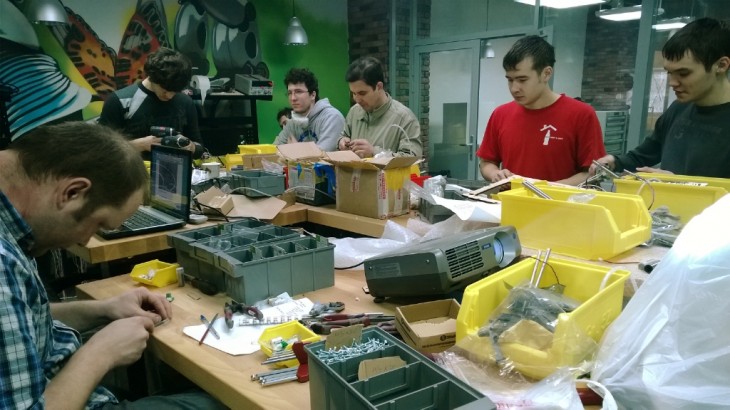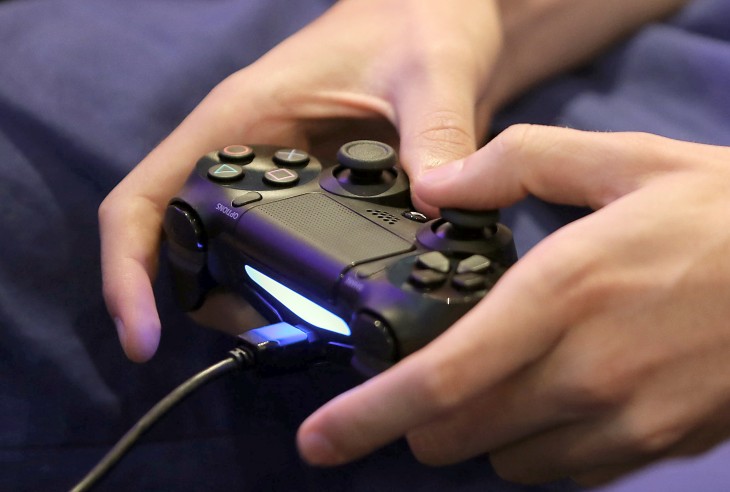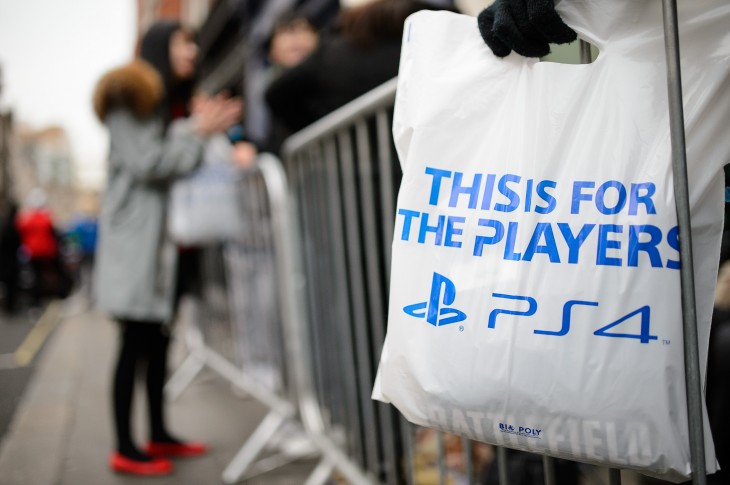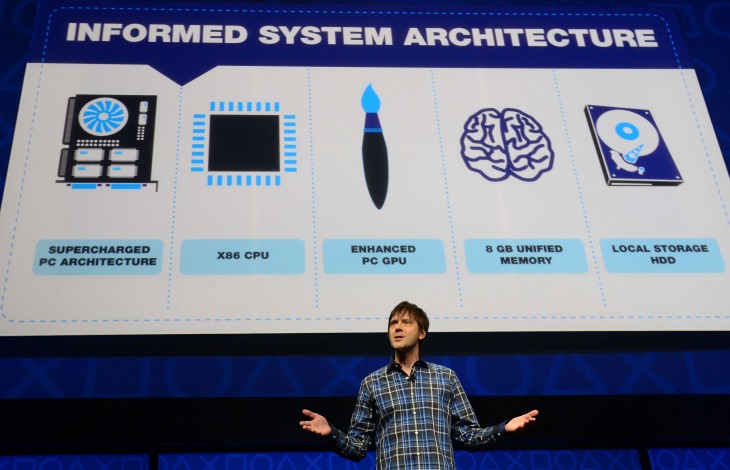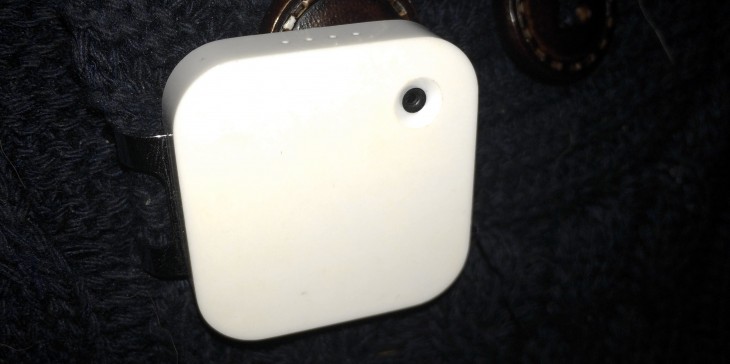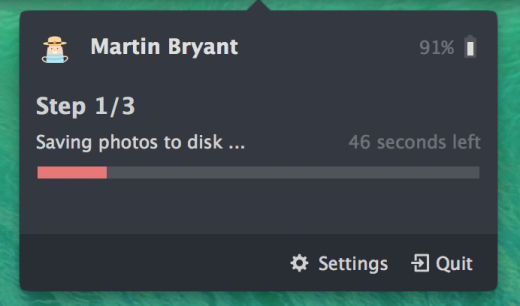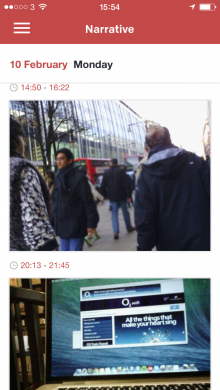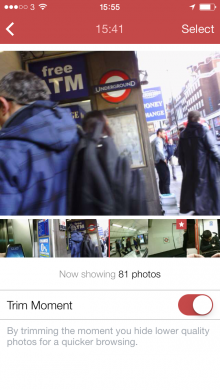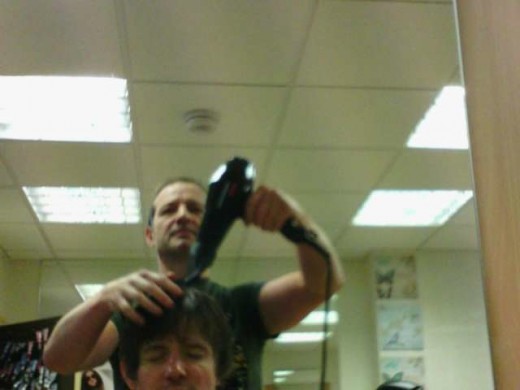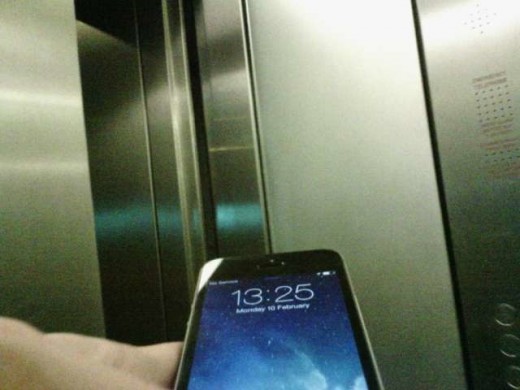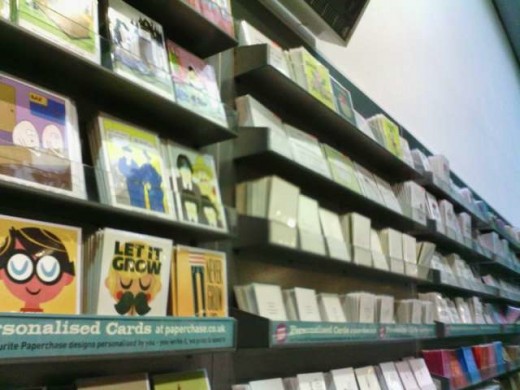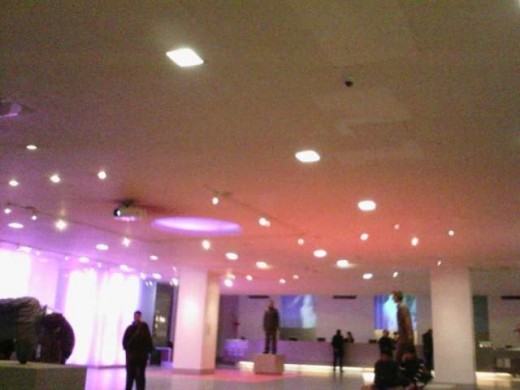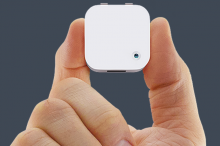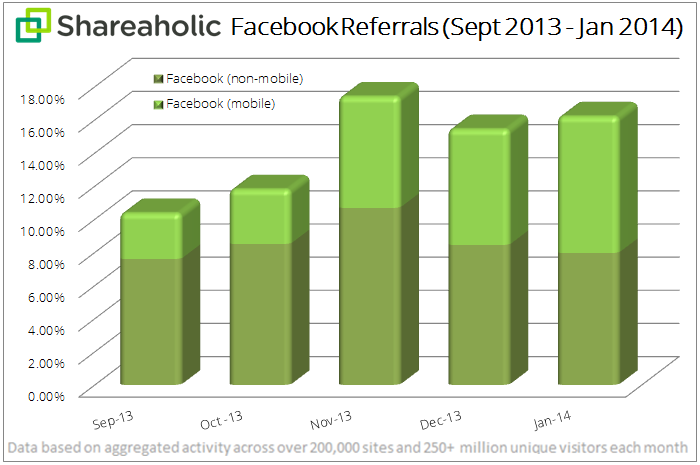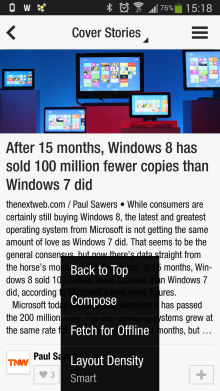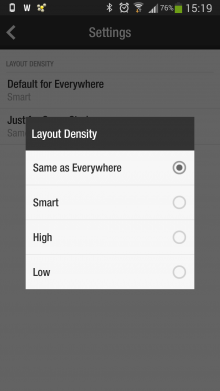The Next Web |
- Learn to work with purpose, or don’t work at all
- I used to steal newspapers…
- Russia opens the doors on a $4m technology park for hardware startups
- Timehop removes the messaging feature from its iOS app, saying ‘fewer than 1% of users’ used it
- Microsoft starts rolling out Xbox One February update with content management, USB keyboard support, and more
- BitTorrent announces mobile broadcasting app using its Live P2P streaming protocol, alpha coming later this year
- Why PlayStation 4 was the best-selling next-gen console in the US last month
- Narrative Clip review: A tiny camera that captures a view of your life every 30 seconds
- More than half of Facebook’s referral traffic now comes from mobile
- Flipboard brings Layout Density controls to Android, now YOU decide how many articles appear on each page
| Learn to work with purpose, or don’t work at all Posted: 15 Feb 2014 04:00 AM PST  David Hassell is the CEO of 15Five. This post originally appeared on the 15five blog. All companies work towards measurable goals. New features in the product, selling target customers and boosting the bottom line. But goals are meaningless without knowing why you're aiming for them. Seems obvious, but far too frequently we forget to examine why certain objectives were created in the first place. As business leaders, knowing the "why" is the critical compass of your organization. We often focus only on the "what" and the "how" forsaking the raison d'etre and the opportunity to foster our team according to the true mission, which is likely more than just making money. We believe most businesses strive to have an impact on the world and want to encourage leaders to develop their employees according to the big vision of the company. Above all elseSome companies seem to just get it right. Beyond the products and services they create, they inspire a religious following of customers. Competitors try to duplicate their efforts and while they can be successful, they always fall short. Why is Dell unable to ascend to the level of Apple? What makes them different? Simon Sinek shows us how industry leaders distinguish themselves, not by what they produce but by articulating their "WHY". Apple has a very clear WHY (they believe in challenging the status quo) and that is how they distinguish themselves from others who create similar products. Before we ever began writing the first line of code, we asked "Why 15Five?" We developed our software out of a desire to improve companies and the people who work for them in a very tangible way by addressing a common problem. We determined that fluid communication was one of the biggest challenges companies faced. Only then did we begin creating our lightweight tool for companies to develop their unique language and for employees to share their voices. Learn a new languageSince a business is little more than several dedicated individuals coming together to fulfill a common purpose, without team cohesion, that vision can never be realized. Teams gather together around a vision and execute that vision around common themes and dynamics – what has become known as workplace culture. Culture is based on and cannot survive without a common language. What is your shared way of speaking? Do you tell people that they "should" do that thing, or do you "offer" a solution? Maybe you simply reframe the problem so that they are empowered to discover the solution on their own. Are you a boss and a manager? Or are you a sponsor and mentor? The way we communicate is inherently woven in our culture. These distinctions seem basic but they form the solid foundation upon which businesses grow and flourish. Choose each word carefully. Change a word or two and the sentence transforms. Suddenly, the paragraph has new meaning, and the entire chapter feels different. Finally, we have a novel that motivates and inspires instead of just a collection of words that merely provide information. Our cultural language revolves around transparency. We ask specific questions and provide a platform for employees to speak freely about their challenges, triumphs, and desires. We believe that to get the answers you seek, you must ask the right questions. The answers become conversations and those words become actions. A shared language leads to the shared vision that keeps us working late on projects and it is the reason that those extra efforts feel more like pleasure than work. Managing not to manageAs an example of the impact of language on culture, take the word "management". In one sense, the manager is the decision maker who controls the employee's daily tasks. But effective "management" is more like mentorship. Team members are given direction to produce results that meet the company's needs, but also to foster their personal and professional growth. In our culture, we provide space for employees to flourish and trust that they will not fail. I have found that the most effective mentors know when to offer hands-on support and when to step away and let the employee struggle to understand a new idea or cultivate a new skill. Instead of just overseeing tasks, develop your talented team by understanding their need for support. As financial growth leads to larger teams, different products or services, and exciting new objectives, remember your why. Breathe it into your culture and your language, and allow it to guide the way you communicate with your team. Your "what" and "how" will surely change over time, but without collective commitment to your purpose, "what" you do is just work. This posting includes an audio/video/photo media file: Download Now |
| Posted: 15 Feb 2014 02:48 AM PST  As a kid I used to steal a newspaper, every morning. On my way to the train station I passed a shopping mall. The delivery guy dumped a whole stack of newspapers there every morning and someone else cut the pack open just before I arrived. Every morning I sneaked up to the entrance of the mall, sure I was about to get caught today, and quickly scooped the top newspaper of the stack. I never knew what newspaper was on top so I read a variety of newspapers and because I had stolen it, I read it from front to back on my 30 minute train ride to school. Nobody told me I had to read a newspaper. I just did, because I could. When I turned fourteen, I dropped out of school. And because nobody forced me to read books, I just did. I started with secondhand books that were well designed. Then I started borrowing books from my parents collection. My mother helped me pick nice ones and, without forcing me or making it feel like homework, guided me though all the classics. I read every book Kafka ever wrote, everything by Dostoyevski (yes, including The Brothers Karamazov) and every other major Russian writer, a lot of philosophy and every greek tragedy I could get my hands on. My mother did some illustration work for magazines so I also read every complimentary copy they sent her. That included architecture and design magazines, a monthly magazine on women's rights and a farmers magazine with the latest news on tractors and fertilizer. At one point my parents sat me down for a conversation and explained to me that although they really appreciated my interest in reading they wanted to ask me to stop opening and reading all their mail. Now I have two kids of my own and I see how hard it is to motivate them. I see how their teachers are struggling to make kids learn, and how a good teacher makes learning interesting and seemingly effortless, while a lesser teacher invokes an adverse reaction in kids. I can't help but think that I'm lucky that nobody ever told me I HAD to read books. That would have probably taken away my appetite for reading in a heartbeat. That never happened so I ended up reading more books than even most of my more 'educated' friends. A few days ago I signed up for an account at a service called Slack. Usually when I sign up for an account somewhere I postpone the part where I have to fill out an account form, upload my avatar, and enter a lot of information about myself. The developers at Slack decided to do things differently. When you first sign up you are greeted by a robot: Slackbot. This is a very simple question and answer robot that has just enough humor (but is no Clippy either) to keep you entertained and who asks you a few very basic questions. Slackbot asked me for my first name, then my last name and this went on for a while with interactions like these:
As you can see, the interaction was limited, but interesting enough to entice me to continue with the process. Instead of making setting up your account the dull part of getting started, these developers geeked out and built something cool. A few years ago we launched a paid feature at one of our startups. The procedure to upgrade wasn't airtight, meaning that if you were smart you could bypass the payment page and upgrade for free. The developers were eager to rewrite the whole process to make it airtight. But then someone proposed to keep it like it was, but add a message for the people who bypassed the payment process. Something like "Wow, if you took the trouble to bypass our payment system you must really like our service! Okay then, you've earned a free account. Of course, if you would like to support us with a payment after all you can always go back and pay. Either way, thank you for using our product" The reasoning was that we would lose a few dollars, but gain very loyal users and make a good impression either way. I'm sure the people who were smart enough to figure out how to use that service for free used it with a lot of pleasure and helped spread the word, probably even more than the people who paid for our service. In other words; nobody likes to do things if they HAVE to do them. Find out where the friction is in your service or product and see if you can make it seem like your users hack, steal or bluff their way in. They will enjoy it a lot more. Just like I really enjoyed reading that stolen newspaper. P.S.: Hey kids, you shouldn't steal! As soon as my parents found out I was stealing newspapers they gave me hell for it, and soon after that they started giving me some money every morning to just buy a newspaper. This posting includes an audio/video/photo media file: Download Now |
| Russia opens the doors on a $4m technology park for hardware startups Posted: 15 Feb 2014 12:01 AM PST  Following the trend of hardware startups becoming increasingly popular, two former leaders of Russian government-backed technoparks have launched one of their own in Kazan, Republic of Tatarstan (800 km from Moscow). Dubbed Navigator Campus, the new project is a mixture of a coworking space and startup accelerator. The technology park's infrastructure includes its own angel seed fund to invest into startups incubated there. Investments in the technopark to the date have reached $4 million, of which $1 million was paid by the founders and the rest by private investors. Among the park's venture partners, which will be investing in its resident startups, are Runa Capital, Quantum Wave, Almaz Capital Partners, Phystech Ventures, and Grishin Robotics. The campus has already opened its doors, but the work on it is far from finished; according to the founders, in the coming years Navigator will expand to 6,000 m² of space, 800 workplaces, and 200 residents. Total amount of money to have been poured into the project by then is estimated at $10 million. At the moment Navigator has 120 working spaces, 93 of which are already occupied. To become a resident of the campus, a startup has to pay about $4,000 per year. Among the 14 projects coming from different parts of Russia and Ukraine are three that have already raised money in one way or another:
"Engineers are granted access to scientific and business experts, VC mentors and hardware industry leaders: Dell, Samsung, IBM, Cisco, Intel, Foxconn etc. I am sure we soon shall see more venture-backed hardware deals in Russia," said Serguei Beloussov, Runa Capital senior partner and CEO of Acronis. The Republic of Tatarstan can be called a state of government-backed technology parks as it's hosting dozens of them focusing on a broad range of areas from oil chemistry to IT. Ramil Ibragimov and Vasil Zakiev, who have founded Navigator Campus, used to manage two of them, in Kazan and Naberezhnye Chelny. Now they plan to raise another $20 million to open technology parks similar to Navigator Campus in two big neighboring cities — Ufa and Perm, — while their 10-year plan sees creating a vast network of such places in every part of Russia. This posting includes an audio/video/photo media file: Download Now |
| Timehop removes the messaging feature from its iOS app, saying ‘fewer than 1% of users’ used it Posted: 14 Feb 2014 09:19 PM PST 
We asked company co-founder and CEO Jonathan Wegener about the removal and he said that it was to make way for future product innovation. It turns out that "fewer than 1 percent of users" were sending messages to one another and Timehop felt that there were better opportunities for the wasted resources. Wegener says, "We want to keep the app focused and easy to use. Feed the winners, starve the losers!" There's no plans yet for a replacement system, but Wegener says that the community has been creating its own makeshift system — taking screenshots of their time capsules and sharing them via SMS. In the future, Timehop will have some new social features to help with sharing, but they will look very different from what's currently being used. For those of you who want to use Timehop but aren't using an iOS device, Wegener tells us that an Android version is expected to be released later this month or in early March. Photo credit: LOIC VENANCE/AFP/Getty Images This posting includes an audio/video/photo media file: Download Now |
| Posted: 14 Feb 2014 01:14 PM PST Microsoft today started rolling out the Xbox One February update, three days after it was initially scheduled to go live. The first system update was released just two months ago, fixing a slew of issues. Here are some of the new features in today's update:
Most Xbox One owners who use "Instant On" (the low power state that lets you say "Xbox On" to turn on the console) will get the update when they turn off their console: everything will happen automatically during off-peak hours in your local time. If you're not using the feature, you'll be asked to manually download and install it soon. The next update is scheduled for March 4. See also – Xbox One review: A multimedia extravaganza that also plays games and Overview: Here's how Skype will work on the Xbox One This posting includes an audio/video/photo media file: Download Now |
| Posted: 14 Feb 2014 11:21 AM PST BitTorrent today announced plans to introduce the first Alpha product based on its Live P2P streaming technology: a new mobile streaming application coming later this year. Unfortunately, the company wouldn't offer any more details beyond "The first app built using BitTorrent Live distributed technology will bring P2P broadcast to mobile devices." Back in March 2013, BitTorrent released the Live P2P streaming protocol as a beta experiment with the motto: "Live streaming by the people, for the people." It's built to remove streaming barriers like bandwidth, cost, and infrastructure, and actually becomes more resilient as more people tune in. With smartphone shipments on the rise, a mobile solution makes sense as a first test for the protocol. See also – BitTorrent launches Live P2P streaming protocol in open beta, cuts costs for anyone looking to broadcast and BitTorrent launches SoShare, an 'unlimited' file delivery service that lets you send up to a terabyte for free Image Credit: Philip MacKenzie This posting includes an audio/video/photo media file: Download Now |
| Why PlayStation 4 was the best-selling next-gen console in the US last month Posted: 14 Feb 2014 10:41 AM PST  The PlayStation 4 was the best-selling next-gen console in the US last month, according to the latest estimates released by NPD. Although the exact numbers weren't published, Sony says it sold nearly double the amount of its closest competitor, which NPD has confirmed as the Xbox One. Although the perceived rivalry between the PlayStation 4 and the Xbox One will always dominate the headlines, it's worth noting just how successful and effective Sony has been on its own at the start of this generation. The Japanese firm had seven years to learn from its early mistakes with the PlayStation 3 and these latest NPD numbers suggest that it's done exactly that. What follows are what we consider to be some of the key factors and decisions that Sony has made to give the PlayStation 4 a near-perfect start. PriceIn the US, the base unit of the Xbox One currently costs $100 more than the base unit of the PlayStation 4. If you forget the additional peripherals, in-store bundles and pre-order games, that is the price gap between these two consoles. It would be a stretch to say that the cost of a console is the most influential factor in the average person's buying decision. Price does play an important role though, especially for anyone on a budget. With an extra $100, you can pick up two other full-price, packaged games such as Battlefield 4 and Need for Speed Rivals, or an extra controller (or two, at a pinch) if you want to get some of your friends and family members involved. For comparison, the entry-level PlayStation 3 cost $499 at launch, which was $100 and $200 more than the Xbox 360 Premium and Xbox 360 Core respectively in the US. ControllerMany will argue that the Xbox 360 controller is one of the best gamepads ever made. While Sony made very few aesthetic changes between the DualShock 2 and DualShock 3, Microsoft made massive improvements to the original Xbox controller for when it released the Xbox 360. (Although the less said about that squishy D-Pad, the better.) Clearly, Sony was taking notes; the DualShock 4 is by far the best controller the firm has built to date. The official gamepad for the PlayStation 4 has a little extra heft and its analog sticks are now slightly further apart, with a small concave pool to stop your thumbs from suddenly slipping. It's a clear improvement. While Microsoft has made its own revisions for the Xbox One controller, I know a number of people who still prefer the Xbox 360 controller. It wasn't necessarily a misstep – the force feedback triggers are considered to be an excellent addition – but the consensus seems to be that the new controller is a step sideways, rather than forward. Targeting gamersTraditionally, most early adopters of any new console can be defined as "gamers". With the exception of the Nintendo Wii in 2006, it's always the most passionate players and platform supporters that pick up new hardware in the first few months. They're excited about owning a new platform and don't mind buying one before the inevitable price-cut and discounted bundles hit store shelves. Furthermore, they're happy to own a new console before any top-tier games have been released for it. With this in mind, Sony targeted gamers with its early messaging and marketing for the PlayStation 4. It couldn't have been clearer, given the tagline was : This Is For The Players. Microsoft, meanwhile, used the Kinect and its TV integration to target the average consumer. While some of the company's early adverts did cater to gamers with imagery of exclusive titles such as Titanfall, Forza 5 and Dead Rising 3, overall its focus was far broader than Sony's. PlayStation PlusSony transformed what could have been a red cross on the PlayStation 4′s scorecard into one of the most beloved parts of the system. Just like the Xbox 360 and Xbox One, Sony asks that you pay an additional subscription – called PlayStation Plus – to access online multiplayer with the PlayStation 4. While that's a significant reversal from the PlayStation 3, Sony has effectively buried it with a bundled service called Instant Game Collection. As part of the membership, PlayStation Plus subscribers can download a number of video games for free to their PlayStation 4, PlayStation 3 and PlayStation Vita. For its next-gen system, this included Contrast and Resogun at launch, followed by Don't Starve in January and Outlast in February. These are smaller titles from independent studios, but each of them offers a creative, high quality experience for the system. The initiative has been incredibly effective at solving one of the most obvious problems with a console launch – a distinct lack of games. In short, PlayStation 4 owners feel like they're getting even better value for money. Microsoft has a similar initiative called Games with Gold for the Xbox 360, but it's yet to arrive on Xbox One or offer the same caliber of titles available on PlayStation Plus. Indie loveTo reinforce its marketing campaign 'This Is For The Gamers', Sony highlighted its support for independent game developers during its E3 press conference. Almost every gamer and journalist I've spoken to appreciated the gesture, as it emphasized Sony's support for the grassroots 'indie' movement, where much of the industry's innovation and young talent is being nurtured at the moment. Some of the most anticipated games that were shown, such as Transistor, Galak-Z and The Witness, are still in development. Even so, the influx of indie titles that have arrived as part of the Instant Game Collection has quickly solidified the PlayStation 4′s reputation as an indie-friendly video game system. For gamers and developers alike, this creates the perception that Sony has its heart and priorities in the right place. Next: Power, Twitch and PlayStation Now… PowerWhile no-one can definitively say that the PlayStation 4 is more powerful than the Xbox One, a number of cross-platform games show that Sony's machine has a slight edge. Here are the facts: Call of Duty: Ghosts runs at native 1080p on the PlayStation 4, but only 720p on the Xbox One. Battlefield 4 runs at 900p, versus 720p. Assassin's Creed IV: Black Flag runs at 1080p, versus 900p. Across several titles, the PlayStation 4 is running at a higher resolution than the Xbox One. Graphical fidelity isn't the whole story, however. Performance can be attributed to many different elements, including frame rate, scale, physics and latency. It's also possible that developers will, over time, adjust to both hardware platforms and the differences between the two will become even more marginal. Nevertheless, the PlayStation 4 is now considered to be the more powerful console. For comparison, Sony based the PlayStation 3 on Cell architecture, which led to a few early cross-platform games looking better on the Xbox 360. This time around, Sony went for the more familiar x86 architecture and in these early bouts with the Xbox One, the PlayStation 4 is taking the win. Twitch streamingSony has a small, but growing group of customers that are promoting the PlayStation 4 for free. The console supported Twitch, the most popular live streaming platform for games, at launch with a refreshingly simple interface. Just press the share button on the controller, followed by the 'broadcast gameplay' option and you're all done. Streaming has become a hugely popular and influential part of the gaming community. In the past, broadcasting and recording footage from a console has been notoriously difficult, effectively capping the number of people that could get share their gameplay experiences. With built-in Twitch support, anyone can stream a game – and have a potentially large audience watch them for free. For next-gen exclusives such as Knack and Killzone: Shadow Fall, that's an extremely effective and organic marketing tool for gamers. If you're wondering about the Xbox One, it's expected to land sometime in the early part of this year. PlayStation NowPlayStation Now is Sony's wild card at the moment. The idea of a Netflix-style video game streaming service is incredibly appealing, but as firms such as OnLive have found out, delivering it with an effective business model can be wrought with difficulties. Although Sony has already shown PlayStation Now in action – a beta program is currently underway – a number of questions remain unanswered. How much will it cost? How many games will be available? What will the latency be like? For the PlayStation 4, the service could give the next-gen console an unprecedented number of older games for players to enjoy. Given that the system has no backwards compatibility, that means top-tier PlayStation 3 exclusives such as The Last of Us, Uncharted and Ni No Kuni: Wrath of the White Witch would be available to customers who may have only bought an Xbox 360 in the previous generation. Although it's not available just yet, the promise of PlayStation Now will have been enough to tempt some customers into picking up a PlayStation 4. Another wise move from Sony, it would seem. Future exclusivesWhile Titanfall will almost certainly help Microsoft to shift a bucketload of Xbox One consoles, Sony has its own share of platform exclusives in the pipeline including Infamous: Second Sun, Driveclub, The Order: 1866 and a fresh instalment in the Uncharted franchise. Sony has been upfront about the first-party video games that it has waiting in the wings. In the previous generation, the PlayStation 3 had a strong line-up of exclusives – arguably more so than the Xbox 360 – and if can maintain that perception, players will continue to buy PlayStation-branded hardware. Image Credit: Ben A. Pruchnie/Getty Images / OLIVER BERG/AFP/Getty Images / Eric Thayer/Getty Images / ROBYN BECK/AFP/Getty Images / EMMANUEL DUNAND/AFP/Getty Images / Ethan Miller/Getty Images This posting includes an audio/video/photo media file: Download Now |
| Narrative Clip review: A tiny camera that captures a view of your life every 30 seconds Posted: 14 Feb 2014 10:05 AM PST  I have a memory that when I was eight years old, my dad collected me from school one day with a new exercise bike slung over his shoulder. Now I think about it, that seems unlikely – our exercise bike was pretty unwieldy, and my dad can't remember bringing it to the school gates – but in my brain its a crystal-clear image. If only I had a camera with me at all times, automatically logging the seemingly mundane moments that I may want to revisit in the future. That's part of the appeal of the Narrative Clip, a 'lifelogging camera' that has finally launched after almost 18 months of hype and postponed release dates. I've been anxiously awaiting its arrival for most of this time, and just over a week ago it finally arrived. Clip it onThe Clip is a tiny 1.42″ x 1.42″ x 0.35″ camera available for $279 in white, grey or orange, that attaches to your coat, shirt, bag strap or wherever is convenient. It takes one photograph every 30 seconds of whatever's in front of it, with the aim of creating visual diary of your life. Hardcore lifeloggers can wear it all day, grabbing photos of their entire waking lives, while those more interested in capturing a fun event could just wear it to conferences, sporting events, concerts or the like. There are even potential journalistic uses – I'm thinking of wearing a Clip to SXSW this year to see if it captures anything worth using. To make sure it's taking a photo at just the right moment, a double-tap of the Clip's front panel makes it take a photo right away in addition to its automatic snaps. A full battery should last for around 30 hours, and my unit charged from empty in under two hours. One you've finished taking photos, you connect the Clip's Micro-USB port to your Windows or OS X computer and all your photos are removed from the device and uploaded to Narrative's cloud service. You do have the option to keep a copy of all the images you've taken locally, too, although at a rate of 120 5-megapixel images per hour, they can quickly make a serious dent in your local storage capacity. Still, it's probably a good idea to keep copies if you can. Once your photos are uploaded, Narrative processes them and automatically picks the most 'interesting' images based on software algorithms. Photos you took manually are automatically flagged as favorites, too. Your photos are assembled into 'moments' that you can then view via the accompanying iOS and Android apps. By default, you'll get a slideshow of your best images, although a quick tap of a toggle switch reveals every single image you captured, navigable with a swipe of your finger. If there are any images you want to share with the rest of the world, you can share them from the app via Facebook, Twitter, email or Instagram. There's also a download button, presumably to save an image to your mobile device, but it didn't seem to work no matter how many times I tapped it in the iOS version. Presumably, this will change with an update to the app, and I had no such problems with the Android version, which allows you to move photos to almost any app you like thanks to the way sharing works in Google's OS. The Android version suffers a bug that makes sharing multiple photos from the same 'moment' impossible without restarting the app between each one – they're all given the same file name and Android thinks they're the same image. A bug on both iOS and Android means that occasionally timestamps on 'moments' are several hours off, but this seems to resolve itself after a while. However, these are bugs that should be easily resolved in the future, via app updates. Picture qualitySo how good are the pictures? That obviously depends on how visually interesting your surroundings and activities are, but it also depends on the positioning of the camera. For example, I was looking forward to a neat stop-motion summary of a haircut I had last weekend (Tim Bradshaw at the FT recently did the same thing with positive results) but the camera was pointing a little further upwards than I thought it was and the results weren't very well-framed. Later, I met someone for a coffee but despite me thinking my camera was facing forwards toward the person I was meeting, my coat had ruffled up slightly and pointed the camera out of the window instead. I quickly learned that positioning the Clip is everything when it comes to getting shots you'll want to keep. Unfortunately, it's a matter of slow trial and error, as you only see the results of your experiments after you've uploaded them to Narrative's cloud. I found that wearing the Clip a little lower down my coat than I initially expected compensated for its tendency to point slightly upwards. This resulted in more photos featuring people's faces and other things around eye level. From a quality level, the images are sometimes blurred and often poorly framed but this isn't about high-level photography. The Narrative Clip is all about capturing a flavor of your day in a raw way that deliberately-taken photos simply can't match. The etiquette of wearable camerasMuch has been made of the etiquette issues around wearing Google Glass in public, and the Narrative Clip is a good dry run for this, before Glass units start being sold to the general public. I expected to get worried looks from passers-by when they noticed my camera, but nobody seemed to act differently around me, and very few even seemed to notice I was wearing an odd little white box with a tiny lens in its front face. Once someone knew it was a camera though, a funny thing happened – their behavior changed ever so slightly. I told my hairdresser about the camera before he started cutting my hair and he was happy with me to wearing it (especially when he found out it was taking photos, not shooting video or recording audio) but he dropped a hairdryer on my head at one point, an accident he blamed on become distracted by the camera and wanting to make sure he looked okay if it was taking a photo at that point. A few days later, I gave a talk about new technology to a group of librarians while wearing the Clip. During the talk, I explained what the Clip was and they all seemed okay with it. It was only in the pub afterwards, when they realised I was still wearing it, that their body language betrayed discomfort with a camera taking photos of them without them knowing exactly when. I quickly removed the camera and everyone relaxed. These people were happier with the idea of public authorities photographing them via the security cameras that monitor UK cities than they were with a private individual photographing them for reasons of which they can't be sure. There are bound to be some socially uncomfortable moments if you wear a Narrative Clip and another wearable camera regularly enough. Narrative has thought about this problem and stopping the Clip from capturing images is a simple case of removing it and placing it face-down. Considerate use is recommended. Aside from the pricey Google Glass, which can be thought of as the Rolls Royce of wearable cameras (and does so much more), there are others out there closer to the Clip's price point, such as the Autographer (read our review) and the forthcoming video-focused HD MeCam and Parashoot. Assuming that people actually want to wear such devices on a regular basis, we're going to have to work out what the acceptable behavior is for them. So, should you buy one?There are some people who are going to rush out and order a Narrative Clip immediately and use it as much as they possibly can. Casual users will also find benefit from recording sporting endeavours, family days out and the like in a fresh new way. If you can't see the appeal, it probably isn't for you yet, although if this form of recording our memorable – and not so memorable – moments becomes more popular, maybe it will 'click' with you in time. The image quality will no doubt improve in future generations of wearable cameras, so if that's your primary concern, it might be better to wait.
Narrative certainly takes this issue seriously (and explains more to the FT here), but it's something you need to bear in mind, and keeping local backups of all your photos is definitely a recommended move if you can. In addition to the upfront price, it's worth considering that after your first (free) year, you'll have to pay $9 per month for use of the cloud service. Seeing as the Clip doesn't really work without it, this is definitely a point to bear in mind. The Narrative Clip is the most polished of the wearable lifelogging cameras we've looked at to date. Aside from the couple of minor quibbles with the app mentioned above, and the fact that the device's tiny size makes me worry that I'll lose it, the Clip is just as good as I hoped it would be. ➤ Narrative Clip [$279] This posting includes an audio/video/photo media file: Download Now |
| More than half of Facebook’s referral traffic now comes from mobile Posted: 14 Feb 2014 08:00 AM PST  Social discovery and sharing platform Shareaholic today released its latest report for Facebook referral traffic data. More than half of social traffic from Facebook now consists of mobile referrals. Above you can see the last few months of growth as noted by Shareaholic, which tracks 250 million users visiting its network of 200,000 publishers. In January, Facebook's share of visits was 16.21 percent while Facebook mobile was 8.25 percent, or just over half (50.89 percent) of Facebook referrals. When students were going back to school, mobile accounted for over a quarter. Now it's double that. Of course, it's quite possible that the latest data is a peak and that in the next few months mobile referrals will fall back down as a share of overall referrals. Still, it's quite clear Facebook's mobile referral share has been steadily rising for some time now. Two weeks ago, Facebook released its latest quarterly earnings, in which the company also revealed new user milestones: 1.23 billion monthly active users, 945 million monthly active mobile users, 757 million daily active users, and 556 million daily active mobile users. The biggest jump was naturally for mobile users, up 39 percent year-over-year for monthly and up 49 percent year-over-year for daily. 76.83 percent of Facebook's total monthly userbase and 73.44 percent of its daily userbase accesses the social network from a mobile device. Last but certainly not least, the company revealed last quarter that more than half of its advertising revenue now stems from mobile (53 percent). As we've said before, Facebook has successfully transformed itself into a mobile company. It only took about three years, but the data now backs it up: Facebook has more and more mobile users, is driving more and more mobile traffic, and is making more and more money from mobile. See also – Facebook's referral traffic share grew over 48% in Q4 2013, Pinterest was up 30%, but Twitter dipped 4% and Report: Over the past year, search traffic has dropped while social traffic more than doubled Top Image Credit: Brendan Smialowski/Getty Images This posting includes an audio/video/photo media file: Download Now |
| Posted: 14 Feb 2014 07:48 AM PST Flipboard has rolled out an interesting new update to its Android app today, one that let's you decide how many articles are displayed on a given page. The new Layout Density feature is accessible via the main settings menu, and you can select 'high' which means that you'll see a maximum number of headlines on each page, or 'low' which means the opposite. 'Smart', on the other hand, is the default option that lets Flipboard decide the best configuration for each page. Moreover, you can apply this layout to a specific section, or your entire Flipboard library. This is the latest update to hit since 2.2.3 a couple of weeks back, which brought redesigned Cover Stories to help surface more interesting content. You can download the updated Android app now, and there's no word yet on whether this option will be arriving for iOS any time soon. This posting includes an audio/video/photo media file: Download Now |
| You are subscribed to email updates from The Next Web To stop receiving these emails, you may unsubscribe now. | Email delivery powered by Google |
| Google Inc., 20 West Kinzie, Chicago IL USA 60610 | |

